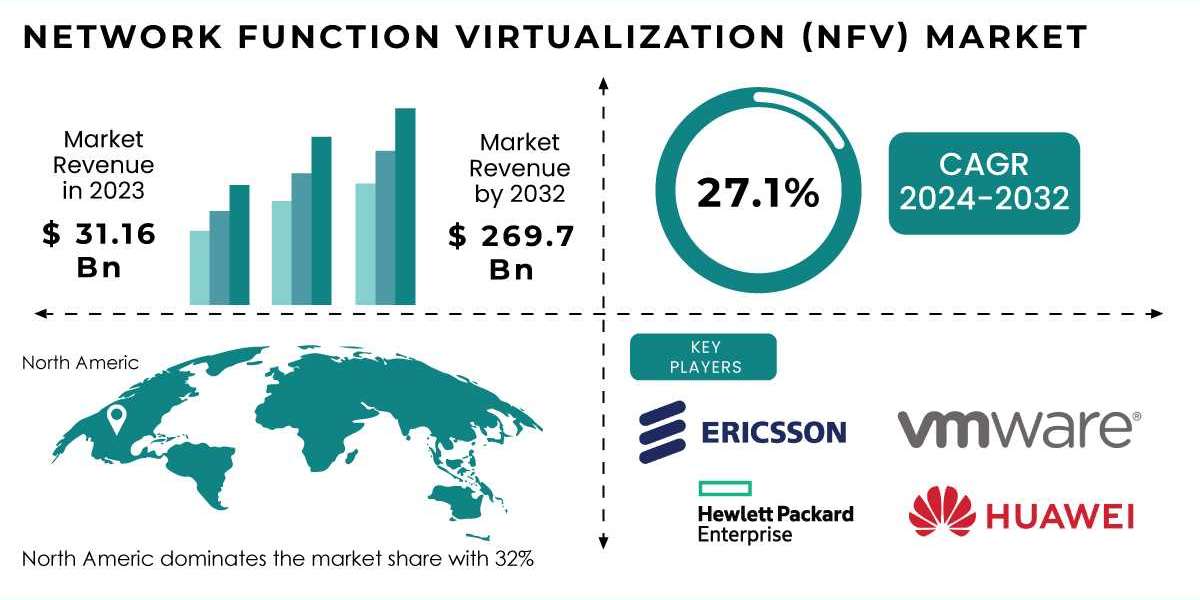Network Function Virtualization 2024
Network Function Virtualization (NFV) is a technology that has revolutionized the telecommunications industry by virtualizing network services that were traditionally hardware-based. It allows operators to run network functions such as routing, firewalls, load balancing, and intrusion detection systems on general-purpose hardware, rather than using dedicated physical appliances. The main goal of NFV is to decouple network functions from proprietary hardware, making it easier for telecom providers to deploy, manage, and scale network services. Network Function Virtualization Market Trends show that more companies are adopting this technology as it provides increased flexibility, reduced costs, and improved efficiency in managing network resources.
Network Function Virtualization Market was valued at USD 31.16 billion in 2023 and is expected to reach USD 269.7 billion by 2032, growing at a CAGR of 27.1% over the forecast period of 2024-2032. This impressive growth reflects the increasing adoption of NFV in both telecommunications and other industries, as organizations seek to optimize their network infrastructure and embrace digital transformation.
How Network Function Virtualization Works
At its core, NFV is about replacing hardware-based network appliances with software running on virtual machines (VMs) or containers, all powered by standard x86 servers. By running these functions as software, network service providers can quickly scale, update, or add new services without the need for extensive hardware replacements or upgrades. This approach is known as "network slicing," where a provider can create customized network services for different customer needs or business applications.
Network functions like virtual routers, firewalls, and load balancers are typically deployed using software from a network function virtualization infrastructure (NFVI), which operates on a virtualized platform. This platform consists of virtual machines and storage, all supported by hardware resources such as compute power, memory, and storage that are abstracted and shared across different network functions. NFV uses orchestration systems to manage these resources, allowing telecom companies to handle the deployment, configuration, and management of network functions efficiently.
Key Benefits of Network Function Virtualization
One of the primary advantages of NFV is cost efficiency. By eliminating the need for specialized hardware, businesses can reduce capital expenditures (CapEx) and operational expenses (OpEx) associated with maintaining physical network devices. Additionally, NFV enables better resource utilization by consolidating network functions onto shared hardware, leading to lower energy consumption and a smaller physical footprint.
NFV also brings greater flexibility to network management. It allows network operators to provision new services quickly, scale existing services as demand increases, and experiment with new technologies and services in a virtualized environment. The ease of integration with cloud technologies is another significant benefit, enabling telecom companies to expand their services into the cloud and offer hybrid cloud solutions.
Moreover, NFV enables a more dynamic and adaptable network infrastructure. With software-driven configurations, network operators can optimize network performance in real-time, adjusting resources based on traffic conditions or application needs. This flexibility helps companies stay agile in an increasingly complex and fast-paced market environment.
Impact on Telecommunications and Beyond
NFV is having a profound impact on the telecommunications industry, especially as network operators seek to handle the explosion of data traffic and the rise of new services such as 5G, IoT, and edge computing. As more services shift to the cloud and require real-time processing, NFV becomes a critical enabler for service providers to meet the growing demand for high-speed, low-latency services.
Beyond telecom, other industries are also beginning to recognize the value of NFV. Industries such as healthcare, finance, and transportation are leveraging NFV to streamline their networking and data management systems. For example, NFV can support secure, scalable communication systems for remote healthcare applications or enable financial institutions to process large volumes of transactions with reduced latency.
Challenges and Considerations
Despite its many advantages, the adoption of NFV comes with its challenges. One of the key obstacles is the complexity involved in integrating NFV with existing networks and legacy systems. The transition from traditional hardware-based systems to a virtualized environment requires careful planning and expertise, particularly in areas such as service orchestration and network management.
Security is another critical concern when adopting NFV. Virtualized networks introduce new vulnerabilities, as the virtual machines hosting the network functions must be secured against potential cyber threats. Operators need to implement robust security measures to protect both the virtualized infrastructure and the services running on it.
Additionally, NFV may require substantial investment in terms of training and skill development. Staff members need to be proficient in managing virtualized networks, cloud computing, and orchestration platforms. Organizations may need to invest in upskilling their teams to ensure a smooth transition to NFV-based systems.
The Future of Network Function Virtualization
The future of NFV looks promising, with continued growth and innovation in the telecommunications sector. As 5G networks roll out globally, the need for flexible, scalable, and efficient network architectures will only increase. NFV is expected to play a pivotal role in 5G deployments, enabling faster service delivery, dynamic network management, and enhanced user experiences.
Moreover, as edge computing and the Internet of Things (IoT) continue to expand, NFV will support the network infrastructure required to handle the massive volume of data generated by connected devices. With its ability to provide agile and scalable network solutions, NFV is poised to remain a key technology in the digital transformation of networks across industries.
In conclusion, Network Function Virtualization is transforming how networks are designed, deployed, and managed. As companies embrace this technology, they can unlock significant cost savings, improve operational efficiency, and enhance the flexibility of their network infrastructure. With rapid market growth and widespread adoption, NFV is set to remain a cornerstone of future network developments.
Contact Us:
Akash Anand – Head of Business Development Strategy
info@snsinsider.com
Phone: +1-415-230-0044 (US) | +91-7798602273 (IND)
About Us
SS Insider is one of the leading market research and consulting agencies that dominates the market research industry globally. Our company's aim is to give clients the knowledge they require in order to function in changing circumstances. In order to give you current, accurate market data, consumer insights, and opinions so that you can make decisions with confidence, we employ a variety of techniques, including surveys, video talks, and focus groups around the world.
Read Our Other Reports:
Digital Forensics Market Trends














